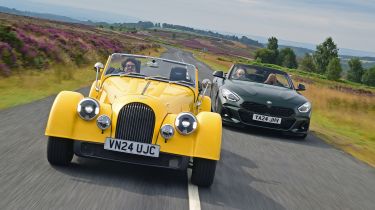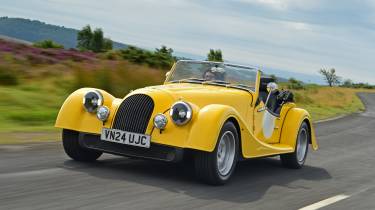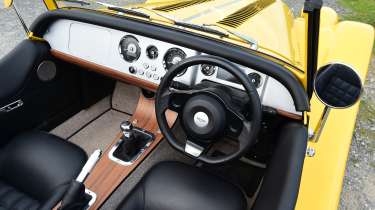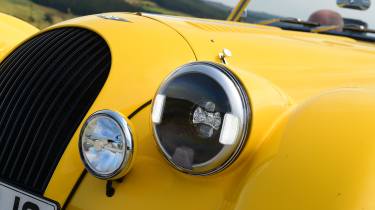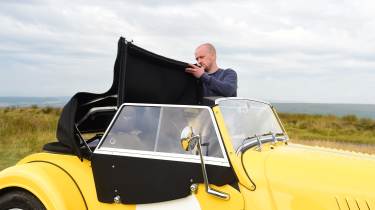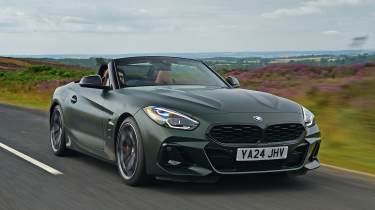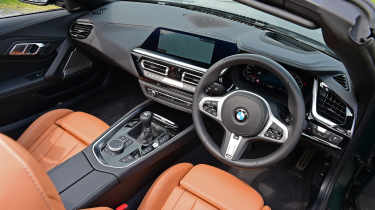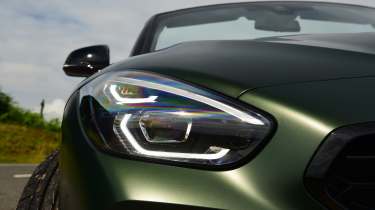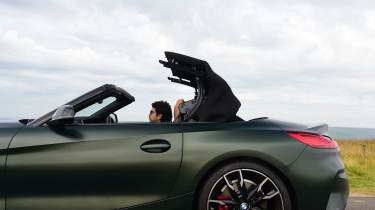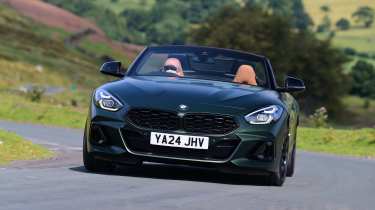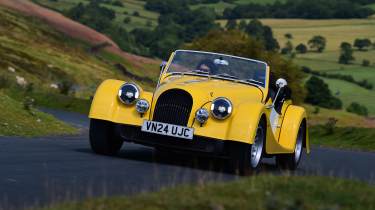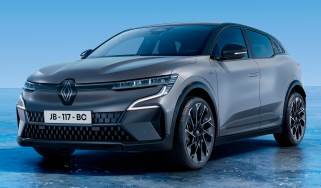Morgan Plus Four vs BMW Z4: retro-modern roadster battle
Britons have a love affair with convertibles that stretches back decades, so we’re trying new roadsters from Morgan and BMW
Few things in life seem as fleeting as a British summer. But that brief opportunity to enjoy the sun makes us all the more determined to appreciate it while we can. That means Britain is very much a convertible car-loving nation.
Historical evidence shows this by the cars we used to make. The British sports car-industry was booming in the fifties and sixties, and one marque, Morgan, still makes models with a heritage that’s easily traceable to that heyday.
The new Morgan Plus Four has by no means stood still, however, with 21st-century improvements crammed into that iconic two-seat roadster shape, making it more suited than ever to compete with its most modern rivals. The latest updates have arrived for 2024, and we’re keen to see what they add to the experience.
To find out, we’re pitching it against a car that has closer ties to the Morgan than you might think. The BMW Z4 shares its engine with the Plus Four and its big brother, the Morgan Plus Six. This latest model is significant because it’s the first time that BMW has combined its most brawny M40i powertrain with a manual gearbox.
Here, then, we have a pair of sports cars that aim to meet somewhere in the middle from opposing sides of tech and performance. But which is best?
| Morgan Plus Four Manual 2.0 TwinPower Turbo | BMW Z4 M40i Handschalter | |
| Price: | £74,406 | £63,230 |
| Powertrain: | 2.0-litre 4cyl turbo, 255bhp, rear-wheel drive | 3.0-litre 6cyl turbo, 335bhp, rear-wheel drive |
| 0-62mph: | 5.2 seconds | 4.6 seconds |
| Test efficiency: | 47.8mpg/10.5mpl | 32.3mpg/7.1mpl |
| CO2: | 137g/km | 202g/km |
| Annual VED: | £600 | £600 |
Morgan Plus Four
The Morgan Plus Four starts from £74,406, but it’s possible to install a load of extras to tailor your bespoke car just so. With the various add-ons fitted to this test car, its price rises to £93,220.
Tech highlights
From the outside, the Morgan Plus Four’s overall look has changed little since the fifties original, from which it can trace its DNA. Some parts, such as the rear arches, are hand-shaped around the original wood buck used to create Morgans more than 70 years ago. Aluminium is used for the chassis, over which a wooden frame is attached. This forms the shape over the rear arches, doors and windscreen base.
Used - available now

2020 MINI
5-Door Hatch
42,441 milesAutomaticPetrol2.0L
Cash £17,050
2022 Toyota
Corolla Touring Sports
27,231 milesAutomaticPetrol1.8L
Cash £17,000
2021 Volkswagen
Touran
32,705 milesAutomaticDiesel2.0L
Cash £18,200
2018 SEAT
Ibiza
62,864 milesManualPetrol1.0L
Cash £8,900The suspension is decades away from the original rigid axle and leaf springs that you’ll find on the back of older cars; here there is a double- wishbone set-up. Our test car was equipped with the Dynamic Handling Pack. This £1,995 option adds springs by Oxfordshire-based suspension expert Nitron, along with adjustable dampers and ride height, plus a rear anti-roll bar.
One benefit of a car that’s length is 30mm shorter than a current Suzuki Swift hatchback, and is equipped with only the luxuries you need, is a low weight; officially, the Plus Four only just breaches the one-tonne mark, at 1,044kg.
Engine: Morgan has turned to BMW for the Plus Four’s engine. The ‘B48’ two-litre, four-cylinder turbocharged petrol motor is used in a variety of the German firm’s cars, including the base version of the Morgan’s rival here, the Z4 sDrive30i.
Power stands at 255bhp and 350Nm of torque when equipped with a six-speed manual gearbox; the latter rises to 400Nm when paired with BMW’s eight-speed auto. The optional sports exhaust fitted to our test car adds an even more rorty soundtrack, with extra pops on the overrun.
On the road
The Morgan Plus Four has always felt like an event on the road, but now it has genuine sophistication, too.
Around town: A low weight and torquey engine mean that, more often than not, you barely need to tickle the Morgan’s throttle pedal to get moving. All-round visibility is great – especially with the roof down – but the turning circle isn’t so good.
A & B-roads: A gentle run along a twisty road is where the Plus Four feels at its best. Roof down at 40-50mph on a summer’s evening, with the view of those curving wings ahead of you, the Morgan feels special in a way that few cars can match.
Push the roadster a little harder and it’s also engaging. Its weight, compact dimensions and sophisticated suspension set-up mean that turn-in feels almost telepathic, with superb response, instantaneous direction changes and a beautiful balance front to rear. But there isn’t much travel in the springs, which means the damping needs to keep a firm hand on things to maintain control.
Factor in a chassis which shudders over harsher bumps, and the Plus Four is at its best on smoother roads. There’s still a unique feel to the way the car corners; what little body roll there is causes it to squat onto the outside rear corner, allowing the driver to exploit a huge amount of traction.
Motorway: The Plus Four proves how efficient modern engines can be when they have minimal weight to haul. On a motorway run between 60 and 70mph, it averaged 60.5mpg; mixed in with spirited driving, this levelled out to 47.8mpg.
Long gearing helps; in sixth gear it’s pulling around 1,500rpm at 70mph. However, motorway runs can become tiring due to a cacophony of wind noise (roof up or down) as the speed rises.
Ownership
Buyers choosing a Morgan will be looking for a unique experience, and little else at any price feels quite so special inside. The simple dashboard design is a world away from modern sports cars such as the Z4, while the soft leather upholstery on the seats, the (optional) wood on the centre console, the thick carpet in the footwells and the metal buttons on the dash all feel fabulous.
Only small details let the side down; Morgan has sourced the indicator stalks from the French side of Stellantis, meaning in effect they’re lifted from a Citroen C3 Aircross, while the gearknob is from Richbrook – an item you could buy from Halfords for less than £30. These are only minor criticisms of an otherwise fabulous cabin finish.
Many of the changes to the latest Plus Four are subtle yet make a tangible improvement to everyday usability. Take the door mirrors as an example; not only do those round, chrome units look great, but they’re also easier to adjust and less prone to vibration than on earlier cars, so they give a better view behind. They can also fold completely out the way to make removing the upper door sections easier. The rear-view mirror is more stable and easier to adjust than before, too.
The driving position makes the best of what is a fairly cramped cabin. The pedals always feel like they’re slightly too far away relative to the steering wheel, so you tend to be sitting a little closer to the dash than perhaps feels comfortable. While the seats are fairly soft, we found that it’s best to take fairly regular breaks to avoid too much backache.
There have been further external improvements. A front splitter houses a number-plate mount that is discreet enough that it will allow prospective owners to either use it or apply the plate onto one of the subtly reprofiled front wings. The rear design is also tidied, with a lower plinth that gives the impression of a floating number plate. It houses the reversing light, too, which is a very neat touch.
Practicality
Space and storage aren’t Plus Four strong points. The front seat area feels fairly cramped and stowage room is limited.
Boot: The Plus Four hasn’t got a boot as such; it’s more of a shelf behind the front seats. It’s okay for a couple of soft bags, and thanks to a catch that releases the roof from the rear, the luggage area is easy to reach whether the roof is up or down.
Roof: A redesigned roof makes life much easier for owners than on the Plus Four’s predecessors. While the old unit forced driver (and often passenger) to fight with fasteners and roof tensioning, the new hood is removed via a couple of catches and folds neatly behind the front seats.
Lifting the roof back into place is possible for one if they’re sitting inside, but it’s easier with two; the slightly tricky part comes when you need to push the hinged side sections straight again.
What to buy?
Which engine and trim we’d choose
- Engines: The Plus Four is available with a manual or an eight-speed automatic gearbox; both are the same price.
- Options: Morgan offers buyers a near-limitless level of customisation; the ‘Fly Yellow’ finish of this test car is sampled from a Ferrari paint, for example. Beyond that, there are seven hood colours and six leather finishes (with 12 piping and 19 stitching shades), while the dash can be trimmed in leather, wood veneers or painted black or in body colour. Throw in grille finishes, splitter colours, decals and numbers, and every Plus Four that rolls out of Malvern will likely be unique.
- Our choice: The manual feels more in keeping with the Plus Four’s character than the auto.
BMW Z4
At £63,230, the BMW Z4 M40i Handschalter costs more than £10,000 less than the Morgan, and that’s even before options. Of course, the BMW doesn’t have the unique handbuilt nature of the Plus Four, but there’s still lots to help it stand out.
Tech highlights
BMW has been able to justify building a sports car thanks to the economies of scale that come with its CLAR architecture, which underpins a huge spread of its saloon car, SUV and full-EV range.
However, that means that the Z4’s scuttle level is somewhat dictated by that platform, which makes the model look a little chunky around the base of the windscreen compared with its more slender predecessor. But that seems like a worthwhile compromise if it means driving fans continue to have a two-seat BMW to buy. The low-slung yet wide shape offers plenty of visual drama, too.
The Z4 uses a double-joint spring strut front axle paired with a five-link back axle, working alongside adaptive dampers and variable-ratio steering. Along with a reinforced front anti-roll bar clamp and rear differential, all of these elements have been tuned specifically for the M40i.
Engine: In its most potent M40i form, the Z4 certainly isn’t short on power. The three-litre turbocharged six-cylinder engine makes 335bhp and 500Nm of torque (the latter’s maximum arrives at just 1,600rpm and carries on through to 4,500rpm), which predictably outpunches the four-cylinder BMW unit in the Morgan.
However, the Z4 also weighs 1,550kg, which means that, at 216bhp per tonne, its power-to-weight ratio actually falls 28bhp per tonne behind the Plus Four’s. As with its British competitor, all of that torque is sent through the rear wheels via a six-speed manual transmission.
On the road
Unsurprisingly, the BMW feels significantly more modern than its rival to drive, but that extra refinement doesn’t mean it’s devoid of fun.
Around town: From the wheel of the Z4, the key difference that strikes you instantly is the level of refinement when compared with the Morgan. The vibration and noises from the powertrain are much better isolated, but it’s the ride which is the most significant difference. The BMW manages to glide over some bumps that jostle the Plus Four across the road, especially when the adaptive dampers are in their most forgiving mode.
A & B-roads: Go for a more focused setting and the BMW retains its composure over bumps, yet becomes sharper to drive. A low centre of gravity, 50:50 weight distribution and that variable-ratio steering do well to hide the fact that the Z4 is carrying a full half-tonne more than its rival.
There isn’t as much feedback through the steering wheel – nor is it quite as light on its feet – but grip is excellent, body control is impressive and its extra suspension compliance means that ultimately the BMW is quicker across a wider variety of roads. Its engine helps here, too.
The BMW’s 3.0-litre motor allows you to ride a wave of torque, accompanied by a rich six-cylinder noise as the engine fills its lungs. Rev it out, which is something that the unit is more than willing to do, and this is a searingly quick car, too.
Motorway: While the Morgan suffers from heavy buffeting at speed, the BMW is amazingly refined in comparison. A subtle wind deflector between the seats helps, but the result is a car that is comfortably quiet enough for roof-down conversations even when travelling at 70mph.
Ownership
After sitting inside the Morgan, the BMW’s range of buttons and screens looks almost busy. The Z4’s low-slung driving position makes you feeling cocooned inside the cabin, though, while the ‘Cognac’-coloured leather seats add a much-needed splash of colour and class to the interior. As is the case with so many modern BMWs, the steering-wheel rim is too thick and squidgy, which removes a layer of delicacy and precision that the otherwise quick responses could offer the driver.
There’s no faulting the build quality, however, and even though there are plastics where the Morgan would use wood or leather, the Z4 still feels solidly put together and suitably expensive.
While running costs aren’t the most important factor when buying sports cars such as these, it’s worth bearing in mind that when it comes to depreciation, the Morgan is significantly better at holding onto its value for longer. It’s predicted to retain 58.7 per cent of its original cost after three years, compared with the BMW’s 46.8 per cent.
That means that despite the Plus Four being the more expensive car to buy, it will lose roughly £30,800 of its original cost (before options), compared with approximately £33,700 of the BMW’s retail price. Even in the every day, the fuel costs will rack up a little more than in its rival. We were generally tracking very close to the official WLTP figure of 32.5mpg, which is impressive for the performance on offer, but some way off the featherweight Morgan and its smaller engine.
Storage: There’s a great deal more practicality on offer inside the Z4’s cabin, though. It has a large glovebox, plus an area to store a smartphone where the wireless charging tray is located. There’s also a further cubbyhole behind the seats and a netted area to hold smaller items. In contrast, the Morgan’s interior only has a small glovebox in which to store items out of sight.
Practicality
A roomy interior, a large boot and an exceptionally quick electric hood mechanism make the Z4 an impressively usable sports car for everyday driving.
Boot: The BMW’s boot space is really impressive for this class of car. Officially, it will hold 281 litres, which is about the same as a typical supermini, and that figure is identical whether the roof is up or down. The boot opening is a little smaller than an average saloon car’s, but the overall space is very long, which means that a set of golf clubs will fit.
Roof: The electric roof takes little more than a flex of a finger to either open or close. It’s fast, too, taking just 10 seconds in either direction. If you’re caught out by a sudden change in the weather while you’re on the move, it’s possible to operate the hood while you’re driving, too, as long as the speed stays below 31mph.
What to buy?
Which engine and trim we’d choose
- Engines: Buying a manual Z4 is expensive. It’s only available with the most potent M40i engine, and it also carries a £5,880 premium over the eight-speed automatic. For the sake of some minor tweaks, rarity value and a third pedal, that’s a lot of cash.
- Options: Most Z4 options are bundled into larger packs. These include the Visibility Pack (£945), with adaptive LED headlights and an auto high beam to avoid dazzling others. The £1,890 Tech Pack has wireless smartphone charging, a Harman Kardon hi-fi system, head-up display, parking assistant, and WiFi.
- Our choice: Manual is unique, and that alone will be enough for keen drivers to pick it
Results
Which car comes out on top?
Winner: BMW Z4
The current generation of the Z4 has always been one of the most usable and practical sports cars around, due to its large boot, rapid roof operation and impressive comfort and refinement. One thing it has always missed ever so slightly is a little edge. Installing a manual gearbox alongside its most potent engine has helped that.
Even if it isn’t the finest manual shift a keen driver will ever find, it opens up an extra dimension of interaction with the car that makes a twisty B-road more engaging than ever before. Yes, the Morgan is more exciting in its element, but the BMW has such a broad spread of roads over which it works so well that it’s a vehicle that we could easily live with every day. A mix of its mini muscle-car attitude and great usability is enough to just secure victory here.
| Pros | Cons |
| Performance | Not the most engaging sports car to drive |
| Comfort | So-so manual shift quality |
| Intuitive tech | Steering short on feedback |
| Large boot | High price for a manual box |
Runner-up: Morgan Plus Four
It’s immediately clear that the latest Plus Four is the most rounded, most convincing Morgan yet. The cabin quality and design are better than they have ever been, while small improvements have made it easier to live with. Superb fuel economy and strong residual values are very sensible reasons to choose the Morgan over the BMW, too.
However, for many sports car buyers, the British roadster will still be a little too uncompromising. Of course, many of the updates can’t address some of the Plus Four’s innate drawbacks, but many of those are what gives the Morgan its unique character, so we wouldn’t want them to change. If you can live with the extra noise, vibration and limited practicality, you’ll find little else on the market that will be able to so consistently put a smile on your face.
| Pros | Cons |
| Sharp handling | Refinement |
| Gorgeous interior | Firm ride |
| Brilliant fuel consumption and residuals | Customisation features are pricey |
| Feel-good factor | Limited internal space |
Rivals and other options
The Z4 wins our twin test, but what else is out there?
- Same money: Mercedes CLE Cabriolet
- Same Class: MG Cyberster
- Used: BMW Z1
- Used: Mazda MX-5
- Coming soon: Porsche Boxster EV
The great debate
What the Auto Express team would do…
John McIlroy, editor-at-large: “Few cars can elicit as much cheer as the Morgan. Whether it’s for the lucky driver or the many passers by who descend on the roadster whenever you come to rest, the Plus Four never fails to raise a smile. It’s the sort of car that people will gladly let out of junctions.”
Richard Ingram, deputy editor: “There’s something so addictive about a car with a minimal weight and loads of torque. The Z4 just about delivers, due to its abundant shove, but the Plus Four feels so light and brawny that it’s like a mini-muscle car. The Plus Six is more bonkers still, with the Z4’s engine in that tiny Morgan frame.”
Dawn Grant, picture editor: “BMW’s Z4 isn’t long for this world, with its petrol-heavy engine line-up likely to be dropped as emissions regulation tighten even more, and cars like this with manual gearboxes are rarer still. It looks like you’ve got until 2026 at the latest to get your hands on one, so we say grab one while you can.”
Paul Barker, editor: “The knowledge of owning a car that has been beautifully hand crafted in Malvern is one part of the Morgan’s huge desirability. If you want to see just how much love and care has gone into your car, then for £480, Morgan will document your car’s construction in a series of photos.”
Dean Gibson, senior test editor: “If these cars are beyond your budget, then the base Z4 is still a great place to enjoy open-top thrills. The sDrive20i has a modest 194bhp, but that is still enough for a 6.6-second 0-62mph time. Starting from £45,170, it’s a much cheaper way into sports-car ownership.”
Prices and specs
| Morgan Plus Four Manual 2.0 TwinPower Turbo | BMW Z4 M40i Handschalter | |
| Price as tested | £74,406 | £63,230 |
| Powertrain | 4cyl in turbo/1,998cc | 6cyl in turbo/2,998cc |
| Power/torque | 255bhp/350Nm | 335bhp/500Nm |
| Transmission | Six-speed man/rwd | Six-speed man/rwd |
| Fuel tank capacity/ spare wheel | 46 litres/£525 | 52 litres/repair kit |
| Length/wheelbase | 3,830/2,520mm | 4,324/2,470mm |
| Height/width | 1,250/1,650mm | 1,304/1,864mm |
| Boot capacity | NA | 281 litres |
| Kerbweight/power to weight | 1,044kg/244bhp per tonne | 1,550kg/216bhp per tonne |
| Turning circle | NA | 11.0 metres |
| Basic warranty (miles)/recovery | 2 years (unlimited)/1 year | 3 years (unlimited)/3 years |
| Driver Power maker position | NA | 14th |
| NCAP: Adult/child/ped./assist/stars | NA | 97/87/91/76/5 (2019) |
| 0-62mph/top speed | 5.2 seconds/149mph | 4.6 seconds/155mph |
| Auto Express economy/range | 47.8mpg/484 miles | 32.3mpg/369 miles |
| WLTP combined | 39.0mpg | 32.5mpg |
| WLTP combined | 8.6mpl | 7.1mpl |
| Actual/claimed CO2/tax bracket | 137/165g/km/37% | 202/197g/km/37% |
| Number of airbags/Isofix points | Two/none | Six/one |
| Parking sensors/camera | No/no | Rear/£550 |
| Lane-keep assist/blindspot/AEB | No/no/no | Yes/£945*/yes |
| Climate control/cruise control | Air-con/no | Two-zone/yes |
| Leather/heated seats/wheel | Yes/£420/no | Yes/yes/£185 |
| Metallic paint/LED lights | £600/yes | £0/yes |
| Keyless entry & go/powered tailgate | No/no | £525*/no |
| Sat-nav/digital dashboard/USBs | No/yes/two | Yes/yes/two |
| Online services/wireless charging | No/no | Yes/£385 |
| Apple CarPlay/Android Auto | No/no | Yes/yes |

